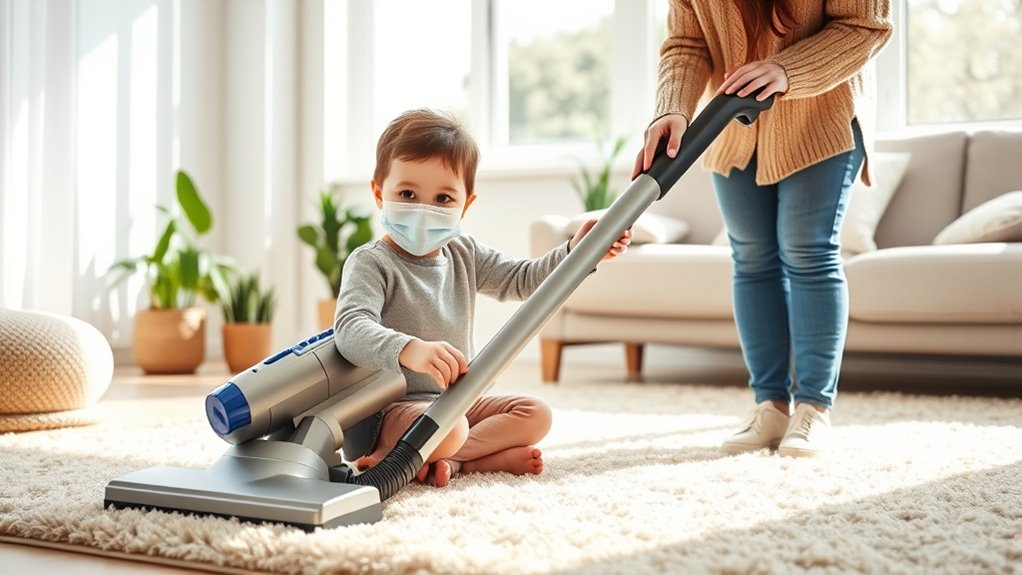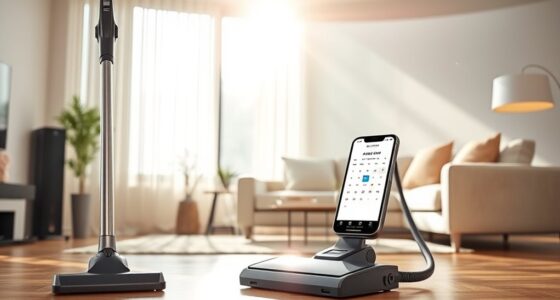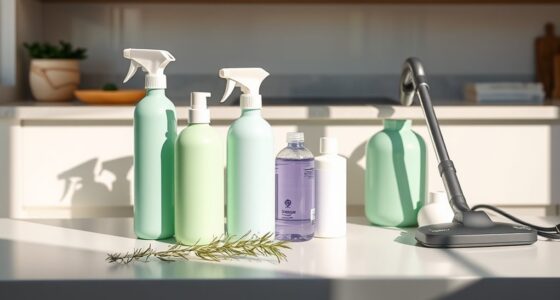To safely vacuum with children who have asthma, use a vacuum with a HEPA filter and a sealed system to trap tiny allergens like dust mites and pet dander. Vacuum slowly and frequently—about once or twice a week—in high-traffic areas while wearing a mask if needed. Ventilate the space during and after cleaning to reduce airborne particles. For more tips on creating a safer environment for your child, keep exploring these strategies.
Key Takeaways
- Use a HEPA-filtered, sealed-system vacuum to contain allergens and prevent dust from escaping into the environment.
- Vacuum slowly and focus on high-traffic areas to effectively remove allergens without dispersing dust clouds.
- Vacuum when children are not present or after they leave the room to minimize exposure to airborne allergens.
- Open windows or use exhaust fans during and after vacuuming to improve ventilation and reduce airborne dust.
- Wear masks during vacuuming and regularly clean surfaces to decrease dust buildup and protect children with asthma.

Have you ever wondered how vacuuming affects children with asthma? It’s a valid concern since the air quality in your home plays a crucial role in managing their symptoms. Dust, pet dander, and other allergens tend to settle on surfaces, and when you vacuum, you can either help or worsen the situation. Proper vacuuming techniques are essential to improve allergy prevention and ensure your child’s safety. If you use the right equipment and follow specific steps, vacuuming can actually contribute to better indoor air quality, reducing triggers that might cause an asthma attack.
One of the most important factors is choosing a vacuum with a high-efficiency particulate air (HEPA) filter. These filters trap tiny particles like dust mites, pet dander, and pollen, which are common allergens for children with asthma. Regular vacuuming with a HEPA-equipped machine can significantly cut down airborne allergens, making the indoor environment safer and more comfortable. It’s equally important to vacuum frequently—at least once or twice a week—especially in high-traffic areas and places where your child spends a lot of time. This routine prevents the buildup of allergens that can cause breathing difficulties.
Choosing a HEPA vacuum helps reduce airborne allergens for children with asthma.
While vacuuming is beneficial, it’s equally important to minimize any dust clouds that might get stirred up during cleaning. To do this, you can wear a mask, especially if you or your child are sensitive to dust. Also, try to vacuum slowly and deliberately, allowing the vacuum’s suction to pick up allergens effectively without dispersing them into the air. Keep windows open or use an exhaust fan to improve ventilation during and after vacuuming. This helps clear out dust particles that may have become airborne, further improving air quality and reducing allergy triggers.
Another tip is to regularly replace or clean your vacuum filters and bags. A clogged filter or full bag can decrease the vacuum’s efficiency and cause it to release dust back into the air. Maintaining your vacuum guarantees ideal performance, which is essential for allergy prevention. Additionally, consider using a vacuum designed specifically for allergy sufferers or those with asthma. These models often have sealed systems that prevent dust from escaping.
Furthermore, recent advances in robotic vacuum technology, such as the integration of HEPA filters and sealed systems, make it easier to maintain consistent cleanliness without manual effort, enhancing allergy management for children with asthma.
Frequently Asked Questions
Can Vacuuming Worsen Asthma Symptoms Temporarily?
Yes, vacuuming can temporarily worsen your asthma symptoms. The noise from the vacuum may trigger coughing or breathing difficulties, while poor air quality caused by dust and allergens stirred up during vacuuming can irritate your lungs. To minimize these effects, use a vacuum with a HEPA filter, keep windows open for better airflow, and try to vacuum when your children are not around to reduce exposure to potential triggers.
Are Cordless Vacuum Cleaners Safer for Children With Asthma?
Cordless vacuum cleaners are generally safer for children with asthma because they lack cords that can cause tripping hazards and often have better filtering systems. Focus on cordless safety by choosing models with HEPA filters to reduce airborne irritants. Keep an eye on the battery lifespan, as older batteries may not perform well and could emit more fumes. Regularly replace batteries to guarantee safe, efficient cleaning and minimize asthma triggers.
How Often Should I Vacuum to Reduce Asthma Triggers?
How often should you vacuum to reduce asthma triggers? Regular vacuuming, ideally twice a week, is key for allergen control and minimizing dust, pet dander, and other irritants. If your child has severe asthma, you might need to vacuum more frequently. Consistent cleaning helps create a healthier environment, but always use a HEPA filter vacuum to trap allergens effectively and keep your child’s airways safe.
Is It Better to Vacuum Before or After Children Are Home?
It’s better to vacuum before your children come home to improve air quality and reduce asthma triggers. Doing so guarantees dust, pet dander, and allergens are cleared, creating a healthier environment. Stick to a consistent cleaning schedule so your home stays allergen-free. This way, when your kids arrive, they can enjoy a safer, cleaner space, minimizing asthma risks and promoting overall well-being.
Can Vacuuming Cause Long-Term Asthma Development in Children?
Vacuuming alone isn’t proven to cause long-term asthma in children, but poor indoor air quality from frequent vacuum use or high noise levels can trigger asthma symptoms or develop sensitivities. To protect your child, use vacuums with low noise levels and HEPA filters, and vacuum when they’re not present. Regular cleaning reduces dust and allergens, improving indoor air quality and lowering asthma risks over time.
Conclusion
Think of vacuuming as guiding a gentle boat through calm waters. With careful navigation and safety tips, you can steer clear of storms like asthma triggers, keeping your children safe on this smooth voyage. When you stay vigilant and use the right tools, you create a peaceful journey where everyone feels secure. Remember, your attentive steering transforms a potentially rough ride into a serene cruise, ensuring your home remains a safe harbor for your little ones.









